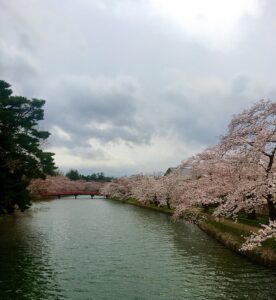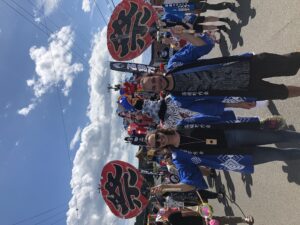The following was written by Regan McAllister, former Fellow in Meridian’s Professional Exchanges Division. Her perspective displays how people around the world are facing the same challenges and how we can be stronger at home by understanding global issues.
Last August, I moved to a small town in northern Japan to be an English Assistant Language Teacher (ALT) through the Japan Exchanges and Teaching (JET) Program. The first seven months of living in Aomori, Japan, were lively and full of seasonal festivals, school events and regional traveling. As I enter my second year, a ‘new normal’ has taken hold of the world, however, aside from a few mild differences, the ‘new normal’ here is not drastically different than when I first arrived.

As the outbreak in Wuhan and subsequent lockdown caught global attention, many people in my community voiced concerns and started taking precautionary measures. Face masks, a commonality in Japanese culture during flu season, were in high demand — and I was strongly encouraged to wear one as well. As the first few cases trickled into Japan in early February, we experienced the initial frenzy of toilet paper and cleaning supply stockpiling that left shelves void. In late February, as cases started to spread among the prefectures, the government encouraged schools nationwide to close for the month of March and reopen with the start of the new Japanese school year in April. This closure would eventually be extended until May but by localized discretion of each school district. Being in one of the first countries to react in this way to the pandemic, I briefly considered returning to America for a short visit to wait out the virus from a safe distance. Had I chosen to do so, I likely would have fallen victim to Japan’s foreign resident re-entry ban that has kept many foreign workers out of the country since it was imposed in April. The restrictions on this re-entry ban are just beginning to be lifted.
During the nationwide school closure, the government promoted teleworking which many businesses have been slow and somewhat resistant to embrace. Large cities like Tokyo have seen an increase in people working from home, however, most towns and rural areas lack technological infrastructure to make this a possibility. In my prefecture, despite schools being out of session, the other teachers and I still reported to work each day, as did many working adults. Technology is rarely used by schools here, thus many lacked the resources and capability to implement virtual learning. In my town, students were instead assigned homework prior to the shutdown, and again when the closure was extended. The concept of social distancing and stay-at-home mentality were (and still are) encouraged, and while many residents of my community chose to (and continue to) abide by this, there has been no mandated lockdown or quarantine imposed. This is partially because the government lacks the authority to force businesses to shut down and, at most, can make strong requests. Japan declared a national state of emergency at the end of April until the beginning of May to subdue the high density of travel that accompanies the national Golden Week holiday. Many businesses close annually for Golden Week, but this year it appeared that all non-essential businesses closed which was the closest experience to a lockdown that I encountered.
Schools in Aomori have resumed uninterrupted since May, with students currently on break for summer vacations. In my town, the usual four-week summer vacation was shortened to just over two weeks to make up for lost days. Since classes have reconvened, many small changes were implemented to help mitigate the possibility of spreading the virus. However, as restrictions have eased, slowly schools and life has returned to normal. All students and teachers continue to wear masks throughout the entire day. Students have their temperatures taken each morning, and if found to be sick are immediately sent home. Desks were spaced out as much as the classroom would allow, but some classes have returned to paired seating arrangements. During lunch, which is provided by the school and eaten together in the classroom, students were forbidden from talking (due to their masks being off). At the elementary school where I work, sanctioned times for handwashing occur multiple times throughout the day. Japanese schools have students clean their schools daily, and this has continued as is. Extra-curricular school events, festivals, field trips and overnight trips were canceled or postponed until the fall, though in July some smaller sporting events took place with added precautionary and social distancing measures. Singing, high-fiving, group activities, and partner work were initially discouraged, but are slowly being re-introduced. Most schools in rural Japan are not air-conditioned, so to ensure that masks can safely be worn by students and teachers, new thermometers that track temperature and humidity as well as signal when there is a high risk for heat-related illnesses have been installed in the classrooms.

While I can only speak on my personal experience working at the elementary and junior high school in my rural town, life isn`t drastically different from a year ago. I am fortunate to live in an area where only 30 cases were confirmed through July, and living conditions are more spacious than in densely populated cities. The most poignant difference in life today versus last year is the cancellation of events and festivals, a big part of the local culture that fills most weekends in summer and early autumn. I have avoided traveling outside my prefecture since February, and the prefectural government still advises residents to avoid travel to Tokyo, the surrounding Kanto and Kansai regions, and riding on trains and planes.
In July, Aomori launched an inter-prefectural travel campaign for residents to help hotels and businesses that were hit by the pandemic. Japan has also launched its nationwide “To-Go Campaign,” which encourages domestic travel to boost tourism spending. The “To-Go Campaign” received much criticism, with concern that increased travel might lead to increased infection rates. Everyone wears masks when outside and most buildings have signs requesting masks to be worn upon entering. Hand sanitizers are found at the entrances to buildings, social distancing tape has been placed on floors for queuing, and most businesses have installed plastic screens between customers and cashiers for check out. Employees are regularly seen disinfecting counters, carts, tables, and seats. Some restaurants have created or expanded outdoor seating or are limiting indoor seating capacity.
In the past month, Japan has seen the highest increase in cases since the start of the pandemic, leaving the future uncertain. There is always the possibility of schools closing again due to a local outbreak, or the government choosing to impose more drastic measures to contain the disease. While the virus persists in my prefecture, the absence of it from my town and the low number of cases surrounding me makes the situation in America seem much more daunting than what I am experiencing. Life is certainly a little bit slower this August, but I feel thankful to be living in a community where people prioritize not only their own health but are sensible and considerate towards the health of those around them as well.















